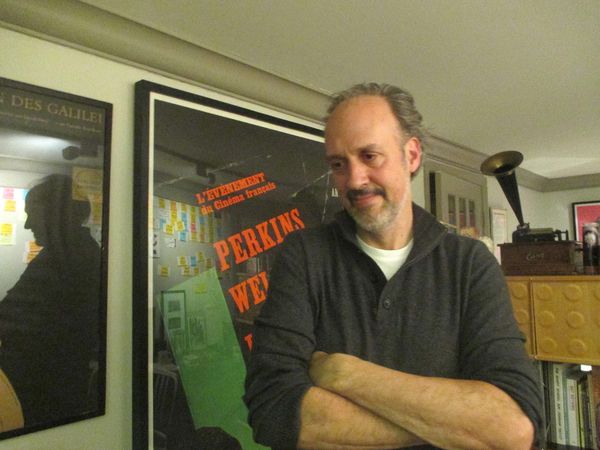 |
| Hitchcock/Truffaut director Kent Jones Photo: Anne-Katrin Titze |
There is only one place where you can see and hear Martin Scorsese, David Fincher, Arnaud Desplechin, Wes Anderson, James Gray, Olivier Assayas, Kiyoshi Kurosawa, Richard Linklater, Peter Bogdanovich and Paul Schrader discuss Alfred Hitchcock and François Truffaut with a narration by Bob Balaban, who played Truffaut's translator in Steven Spielberg's Close Encounters Of The Third Kind.
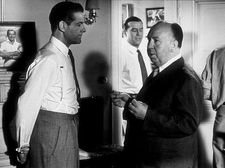 |
| Robert Cummings with Alfred Hitchcock and Ray Milland (Dial M For Murder) |
It all began for Kent Jones with Dial M For Murder, Fahrenheit 451 and Richard Schickel's Men Who Made The Movies that included William Wellman, Howard Hawks, Vincente Minnelli - but no John Ford. For Hitchcock/Truffaut, Kent decided to forego a direct linking of films and opted for an energy driven structure. Eric Gautier shot an early interview in the old Cahiers du Cinéma offices.
Traveling downtown after an afternoon tea with Charlotte Rampling and the director of 45 Years, Andrew Haigh, at the Plaza Athénée, I had already transitioned to Vertigo, the movie referenced most in Hitchcock/Truffaut, next to Psycho.
Anne-Katrin Titze: Half an hour ago, I spoke with Charlotte Rampling about her role in 45 Years and Vertigo came up. She plays this woman who suddenly realizes that she has been living Vertigo and didn't know it. Did you see that in the film?
Kent Jones: Yes. I get the point.
AKT: Do you remember the first time you realised that you were watching a Hitchcock film?
KJ: Yeah, I remember the first time I realised I was watching a Hitchcock film. I went to a school in Lenox, Massachusetts, where I grew up. My mother taught there, actually. I don't think my parents could have afforded to send me there if she hadn't. It was a very good private school. It had a big campus that was right at the edge of the woods. And in the woods, behind the school was the headmaster's house. It was not a boarding school, it was a day school.
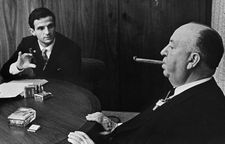 |
| Alfred Hitchcock and François Truffaut creating Le Cinéma selon Hitchcock |
There were two teams, that were signified by colours, sports teams. You were either a blue or a white or whatever. They split off into cleaning crews to clean the campus. Whoever the best cleaning crew was during the semester got to go to the headmaster's house and watch a movie in the basement. And have pizza. So, we went down into the basement and saw Dial M For Murder.
AKT: So Dial M For Murder was the first?
KJ: Yes. The 16mm print. So that was the first Hitchcock film I saw. I was aware of him because there was a very interesting TV series that Richard Schickel did, called The Men Who Made the Movies. It was broadcast on PBS in the early Seventies and it was a series of profiles of eight filmmakers, most of them from Hitchcock's generation. He was one of them, [William] Wellman, [Howard] Hawks - not [John] Ford, Dick Schickel always hated John Ford - Vincente Minnelli. So, I was really captivated by this series. It really opened up the door to how cinema was made. I was really really captivated by the Hitchcock episode.
AKT: The Dial M For Murder in the basement wasn't in 3D then, was it?
KJ: No. Dial M For Murder wasn't really seen in 3D until much later.
AKT: Do you have a soft spot for it?
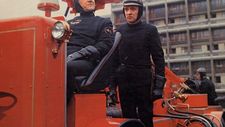 |
| Oskar Werner in François Truffaut's Fahrenheit 451 |
KJ: Dial M For Murder? I don't have a soft spot for the 2D. I think in 3D it's a great film, genuinely. I saw it recently again. I don't know how many times I've seen it.
AKT: After you made Hitchcock/Truffaut?
KJ: Oh, yeah. I look at Hitchcock's films all the time. Dial M For Murder is the greatest 3D film I've ever seen by far.
AKT: The best use of a cane I can think of.
KJ: The best use of objects. The way that he stages it and composes it - the chairs he is shooting from the low angles - so you feel the weight of everything becomes part of the action. Of course, arguably, that happens in all of his movies, but in 3D it's something different - I'm not being very articulate about it - but it's a thrilling experience.
AKT: The first Truffaut film, do you remember that?
KJ: I'm going to guess that it was Fahrenheit 451 because that would play on television and I loved it. I still do.
AKT: Both of these films are very red.
KJ: Dial M For Murder and Fahrenheit 451? They make use of red, for sure. That's true.
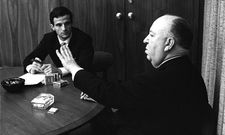 |
| For eight days in 1962, the two directors discussed Hitchcock's career. |
AKT: For Hitchcock/Truffaut you have 80 minutes about a 500 question, week-long conversation. How did you go about structuring? Did you first interview all these great filmmakers?
KJ: No. I listened to the tapes first. Thoroughly. As a matter of fact, I was staying at Arnaud's [Desplechin] apartment and I was sitting in his office, which is my bedroom when I stay at their place, and I was transcribing. I transcribed most of the conversation myself - which is a way of listening to it. You know, 27 hours. As I was transcribing it, I was making notes. I was highlighting areas that seemed like they were alive.
AKT: Space, I noticed, is something you discussed. Also questions of time. Did you ask all the directors the same questions?
KJ: No. It was additive. In other words, I had questions I was focusing on that were based on moments in the Hitchcock/Truffaut conversation that I had highlighted. And I was going to the different filmmakers with these questions, but then, after every interview, I was refining my questions. When I interviewed Arnaud - he was the first interview - I shot him in the morning and I shot Olivier [Assayas] in the afternoon. Eric Gautier shot these interviews.
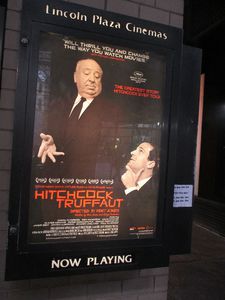 |
| Hitchcock/Truffaut US poster Photo: Anne-Katrin Titze |
Olivier's interview was really nice because it was at the old Cahiers du Cinéma office, which is now Carlotta [Films]. When I interviewed Arnaud, he talked a lot about Vertigo and about James Stewart's sadness. And that brought up the question that I developed that I asked every filmmaker and went pretty deeply into with Marty [Scorsese] - and with James Gray. And in fact, Arnaud's remarks about Vertigo aren't in the movie.
AKT: Martin Scorsese talks about the "religious angle," which was totally fascinating. We've heard him talk about Hitchcock before, but it is so developed now, so refined. There are so many directions one could go with that. About religion, about guilt. And then Arnaud talks about the transfer of guilt.
KJ: Yes, he talks about the transfer of guilt and he talks about it in relation to the people feeling if they are accused of a crime like they might have committed it without remembering it. Which is something that I find, on the one hand, quite truthful; and on the other hand something that only Arnaud would articulate. So I was really happy that he brought that up.
AKT: It's a thing of nightmares. Actual nightmares that you think you committed a crime.
KJ: That's right. Also, I mean, all those things flow into another and that's what I wanted. You know, we started with nightmares and dreams. I said to Rachel Reichman, who is the editor, when we started - I said, I want to go where the energy is. I didn't want to build it in a linear way. I wanted to build it based on energy. I didn't want to build it on what's the thematic connection.
AKT: Nor the linear structure Truffaut was using with Hitchcock - going film by film. That's been done.
KJ: It's not a matter of giving a history lesson about suspense or MacGuffins or stuff like that. That's not making a movie. With all the elements of the movie, it's about the tension and how they're bound together and the concision and the energy of the movie. Based on the energy of the moment between the two of them, between what they say and the images, between what they say and what the filmmakers say… David Fincher is talking about acting and how it's important but not the most important part - and you're seeing Tippi Hedren doing this incredibly directed thing from Marnie. It's interesting for me, the byplay between the images and what is being said.
Coming up - Hitchcock/Truffaut as a portrait of the filmmakers Kent Jones interviewed.
Hitchcock/Truffaut opens in the US on December 4 and is scheduled for release in the UK on March 4, 2016.





















